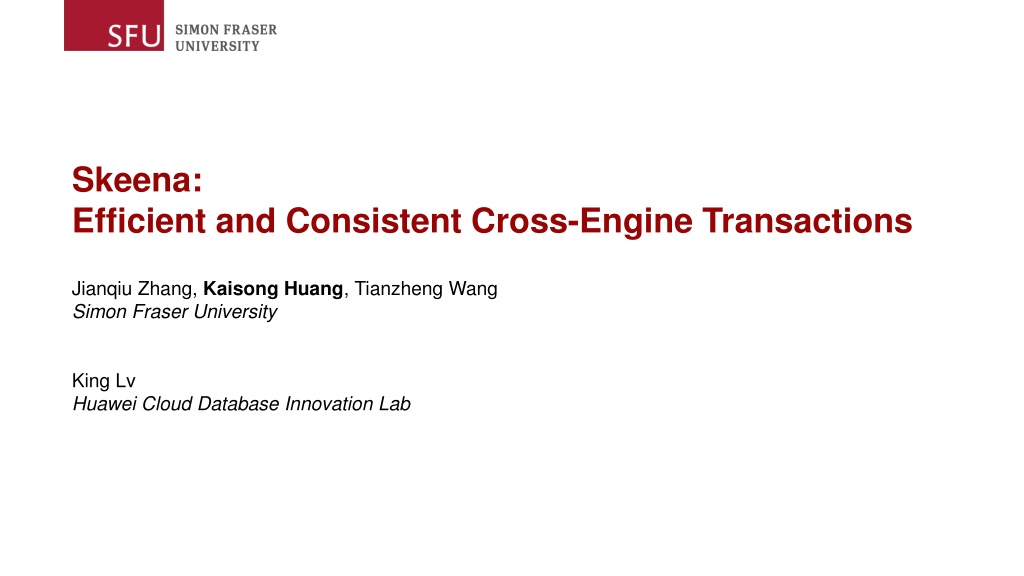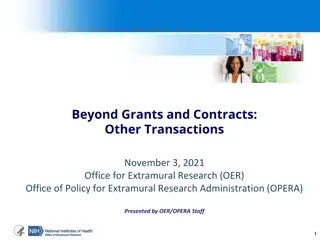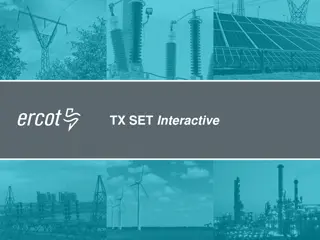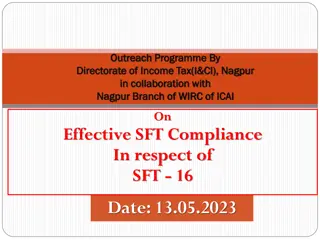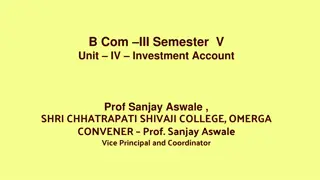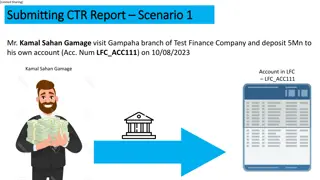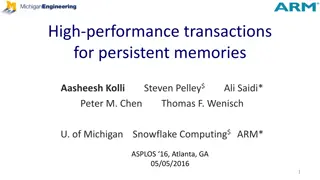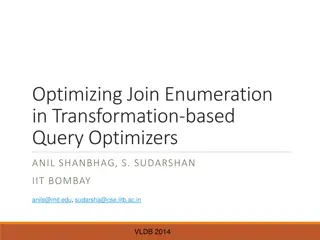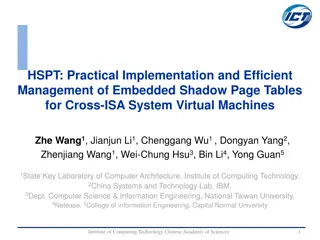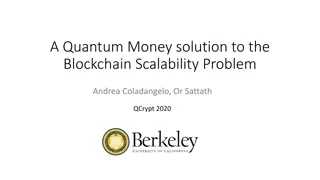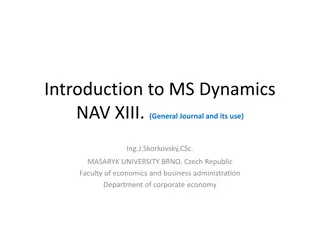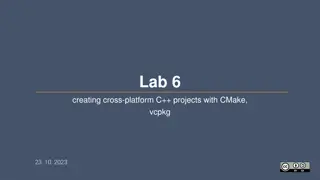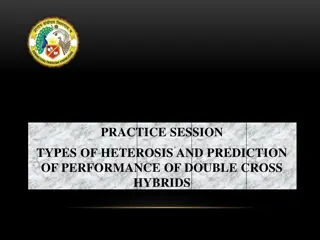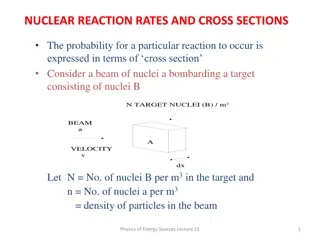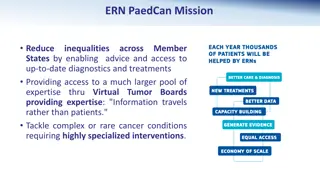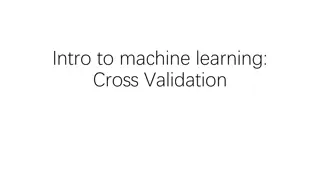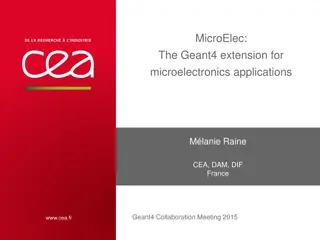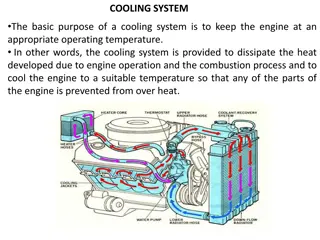Efficient Cross-Engine Transactions in Skeena
Skeena presents efficient and consistent cross-engine transactions, offering solutions to challenges faced by traditional database engines. By utilizing memory-optimized database engines and a multi-engine DBMS approach, Skeena addresses issues such as high costs and compatibility concerns associated with DRAM usage. The architecture allows for the use of fast memory-optimized engines alongside storage-centric engines within the same system, enabling greater flexibility and performance in transaction management. Furthermore, examples illustrate the benefits of Skeena's approach in ensuring snapshot consistency across different engines.
Uploaded on Sep 09, 2024 | 2 Views
Download Presentation

Please find below an Image/Link to download the presentation.
The content on the website is provided AS IS for your information and personal use only. It may not be sold, licensed, or shared on other websites without obtaining consent from the author. Download presentation by click this link. If you encounter any issues during the download, it is possible that the publisher has removed the file from their server.
E N D
Presentation Transcript
Skeena: Efficient and Consistent Cross-Engine Transactions Jianqiu Zhang, Kaisong Huang, Tianzheng Wang Simon Fraser University King Lv Huawei Cloud Database Innovation Lab
Traditional Database Engines are Storage-Centric 1 Skeena: Efficient and Consistent Cross-Engine Transactions
Memory-Optimized Database Engines Multicore processors 100s GB of memory + Many more Working-set fully in-memory, million TPS 2 Skeena: Efficient and Consistent Cross-Engine Transactions
Suppose you are a DBMS architect... Let's use a main- memory database engine. DRAM is expensive. Compatibility issues Difficult to change the entire app. 3 Skeena: Efficient and Consistent Cross-Engine Transactions
Multi-Engine DBMS to the Rescue memory-optimized engine fast >1 engines within one system Normally are fast-slow SELECT * FROM Orders, Products Place tables in suitable engines Common SQL layer Orders Engines implement their own transaction management Execute engine-level sub-transactions Products Sounds trivial just start + commit engine-level sub-transactions? storage-centric engine slow 4 Skeena: Efficient and Consistent Cross-Engine Transactions
Example: Inconsistent Snapshots Snapshot Isolation Example: Inconsistent Snapshots Snapshots Time BEGIN TRANSACTION COMMIT 5 Skeena: Efficient and Consistent Cross-Engine Transactions
Example: Inconsistent Snapshots When we have one engine, When we have two engines, Engine E1 timeline S1 S1 T sees a fresher snapshot of E1 than S does T1 T1 1000 3000 3000+n 2000 Engine E2 timeline S sees a fresher snapshot of E2 than T does T2 S2 10 20 30 30+n S and T start before each other! Key challenge: enforce global snapshot ordering 6 Skeena: Efficient and Consistent Cross-Engine Transactions
Even More Challenges Inconsistent snapshots Serializability Atomicity and durability 7 Skeena: Efficient and Consistent Cross-Engine Transactions
Desirable Properties for Cross-Engine 1. Low overhead Retain the performance of the faster side 2. Engine autonomy Leave engines as-is, if possible 3. Full functionality Various isolation levels 4. Easy adoption 8 Skeena: Efficient and Consistent Cross-Engine Transactions
Poorly Supported in Existing Systems Many restrictions: Not supported when the isolation level of both engines is Snapshot Isolation HiEngine [SIGMOD 22 Industry 2] Cross-engine transactions on the roadmap 9 Skeena: Efficient and Consistent Cross-Engine Transactions
Skeena Photo: Sam A central coordinator that enables processing transactions across different engines 10 Skeena: Efficient and Consistent Cross-Engine Transactions
Skeena in a Nutshell Consists of a cross-engine snapshot registry (CSR) that tracks and selects snapshots as well as a commit protocol for multi-engine database systems A cheap way to enforce global ordering Leverages the characteristics of fast-slow multi-engine database systems Follows the memory-optimized engine s ordering (cheaper to get) 11 Skeena: Efficient and Consistent Cross-Engine Transactions
Cross-Engine Snapshot Registry (CSR) 1000 3000 Engine E1 timeline T S Engine E2 timeline 200 100 T sees a fresher E1 S sees a fresher E2 Transaction E1 Timestamp E2 Timestamp S and T start before each other! 100 200 **without CSR** **with CSR** 1000 S **without CSR** **with CSR** 3000 100 T 12 Skeena: Efficient and Consistent Cross-Engine Transactions
Querying CSR Fast engine timestamp Slow engine timestamp Approaches: full table scan 40 1000 building indexes for each engine s timestamp 2000 60 3000 60 13 Skeena: Efficient and Consistent Cross-Engine Transactions
Lightweight CSR by Skeena Anchor Engine Always access fast side Table -> Range Index = Multi-Index Capacity is fixed but configurable Add new index when full Recycle by the threshold 14 Skeena: Efficient and Consistent Cross-Engine Transactions
Atomic Commit Protocol 1. Sub-transactions pre-commit Obtain commit order (timestamp/LSN) from each engine 2. CSR commit check Whether the transaction can commit without violating correctness criteria (e.g., snapshot consistency) 3. Sub-transactions post-commit Mark new records as visible, finalize log records, etc. 4. Post-committed transactions go through the commit pipeline (More details in paper) 15 Skeena: Efficient and Consistent Cross-Engine Transactions
Easy Integration in MySQL SELECT * FROM Common SQL Layer (parser, networking...) Skeena = 555 LoC Storage-centric engine, InnoDB Memory-optimized engine, ERMIA* ERMIA code changes = 0 LoC InnoDB code changes < 100 LoC (200K LoC in total) * ERMIA: Fast Memory-Optimized Database System for Heterogeneous Workloads, SIGMOD 2016 16 Skeena: Efficient and Consistent Cross-Engine Transactions
Experimental Setup 40-core dual-socket Xeon 6242R Client/server each on a different socket Single vs. cross-engine performance Benchmarks YCSB-like microbenchmarks TPC-C 17 Skeena: Efficient and Consistent Cross-Engine Transactions
Single-Engine Performance Unaffected Experimental configurations: Prepared 250 tables x 250,000 records/tbl for each engine The buffer pool size of InnoDB is 2GB, and the total data size in InnoDB is 13.5GB Scheme ERMIA ERMIA-S InnoDB InnoDB-S Read-only (TPS) 1,427,071 1,430,137 Takeaway: Comparable performance with or without Skeena 456,672 453,781 18 Skeena: Efficient and Consistent Cross-Engine Transactions
Judicious Use of Both Engines Recommended table placements: Payment-Opt: Only Customer in ERMIA to optimize Payment and Order-Status New-Order-Opt: Customer and Item in ERMIA to optimize New-Order Archive: All in ERMIA except History in InnoDB for lower storage cost Memory-optimized for performance Storage-centric for low-cost 19 Skeena: Efficient and Consistent Cross-Engine Transactions
Conclusion Cross-engine transactions: useful but poorly supported Correctness issues Functionality limitations Skeena: efficient and consistent cross-engine transactions Cross-engine snapshot registry (CSR) to tracks and select snapshots Pipelined commit for atomicity Easy to adopt Skeena in real-world systems Negligible overheads Maintains the benefits of memory-optimized engines Find out more in our paper and code repo! https://github.com/sfu-dis/skeena Thank you! 20 Skeena: Efficient and Consistent Cross-Engine Transactions
